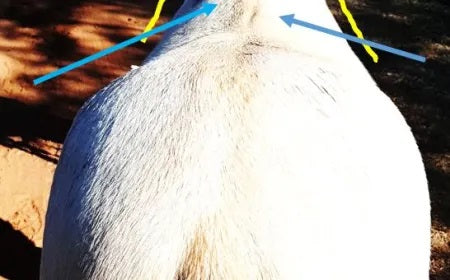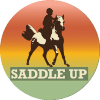April Battles on Fitting Saddles

April (of Holistic Horse Works equine therapy) has lots of great tips here!
Why Saddles Don’t Fit
I invite you to go out to your horse and tie them on a flat surface and stand on a stool or bucket 5-10 foot behind them and notice how one side rump is higher. Now notice how one side of the back where you sit is lower or different shape than the other side of the back. Now look at the shoulders one is bigger yes? Now look at the withers which is little bit curved and not quite directly under the mane hairs. Now you can see why a formed saddle cannot possibly fit the horse. Also look at the 4 hooves from the rear-they do not match either. Now we share with you the reasons why.

Over the past two decades of doing bodywork I find that 99% of most everything I’ve seen in horse issues starts with the 1st rib under the scapula being tweaked or misaligned. The first rib and scapula ties into C7 and T1 spinal segment, where the neck (cervical spine) and upper back (thoracic spine) connects. All the nerves serving the head, foreleg and shoulder blade are in this region and any blockages affects the blood supply to the muscles which leads to excessive muscle tension (tightness) which in turn overloads the flexor tendons and tendons of the lower foot (which can lead to suspensory or tendon tears). Imbalances in this region are seen in foals (globally) from 7 months of age.
If you consider the biomechanics of the horse, and the effects of the imbalances, it is not unlike a car which has 4 points. If one small part of the chassis is out of alignment, the entire body of the car will not function properly, creating major wear and tear on wheels and wheel alignment. The car would probably not drive smoothly, and the increased vibrations on the structure would eventually rattle loose the parts and interior, causing over use and breakdown of the moving parts; same with the horses’ joints not loading correctly.
It is the compensations of the horse, due to the 1st rib misalignment that leads to high/low hoof syndrome that farriers and barefoot trimmers are chasing symptoms of globally. This standing on one low heel and one high heel 24 hours a day shifts everything above the hoof out of alignment; picture how you would feel standing on one low heeled shoe and one high heel shoe all day at work. This will also hinder the horse’s movement. Throwing up issues like difficulties taking the right canter lead, or connecting to one rein only and heaviness on the forehand among others. Most trainers and riders are taught to train these issues out of the horse by repetitive schooling to build the so-called weakened muscle. Us asking more of the same from the horse results in psoas muscle stress, as it tries to keep the heavy forehand going.
The impact of compensation ends up affecting the stifle and hocks and starts creating side bone calcification and ringbone in the front hooves. The load bearing side will be loading and landing properly, be lower heeled with a bigger hoof while the 1st rib misaligned side will not be loading correctly and have a higher heeled narrower hoof, often mislabeled as a club foot (not the same thing as a horse born with a club foot). The horse’s compensation creates medial and lateral imbalances in the hind hooves too. When the horse is standing on 4 hooves that do not match in shape, size and heel height, the body on top of that will not be able to hold its structural integrity. The knock-on effect continues: imbalanced hooves means imbalanced organs and an imbalanced meridian energy system. A 1st rib mis-alignment happens when they run thru deep mud in winter, or a hind foot ripping a front shoe off invariably results in an imbalance in the wither, 1st rib and scapula area. Also horses who lean heavily on solid fences to graze on other side usually drop both 1st ribs which creates both shoulders not being able to move well and Psoas muscle has to over work to pick up heavy front end. This can create Kissing spine symptoms.
We recommend using Equine Musculoskeletal Unwinding therapy, which you can learn at home, to bring balance back to your horse, and keeping them supple with regular yoga stretches can add 10+ years to their rideable life.


Leave a comment
Also in News
Freeform Treeless Saddle Giveaway - Winner
By Paulita Neff March 01, 2024 118 Comments
Continue reading
Saddle Pad Giveaway - Winners
By Paulita Neff February 01, 2023 44 Comments
Winners Announcement! Woohoo – thanks to everyone who entered - our Saddle Pad Giveaway WINNER is Jennifer Morris and her horse Pete!
Continue reading
This Saddle Is Truly Revolutionary
By Paulita Neff September 06, 2022
Continue reading